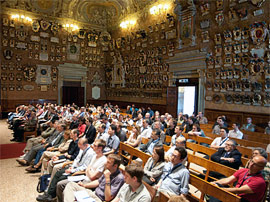Conference
-2011 Jun., Padova, Italy
| Name/Title | The Fifth International Conference on Debris-Flow Hazards Mitigation: Mechanics, Prediction and Assessment (5th DFHM) |
|---|---|
| Venue: Country,City | Padova, Italy |
| Date | Jun. 14to17, 2011 |
| Detail |
The Fifth International Conference on Debris-Flow Hazards Mitigation: Mechanics, Prediction and Assessment (5th DFHM)The Fifth International Conference on Debris-Flow Hazards Mitigation: Mechanics, Prediction and Assessment was held for four days from June 14 to 17, 2011 in the University of Padova in Italy. This conference was first held in 1997 in San Francisco, the United States; the second took place in Taipei, Taiwan in 2000; the third was in Davos, Switzerland in 2003; the fourth was held in Chengdu, China in 2007; and this was the fifth conference. This conference is supported by the Japan Society of Erosion Control Engineering. The number of scientific papers presented in this conference was 119, and about 150 debris-flow researchers from 18 countries participated. Most participants came from Italy, the host nation, followed by the United States, China, Japan, and Taiwan — countries conducting advanced debris-flow research. The conference was held in the University of Padova. The opening ceremony was conducted in the university headquarters, called Aula Magna -Palazzo Del Bo- (Photo), in which Galileo Galilei reportedly gave lectures. Dr. Rinaldo Genevois of the University of Padova made the opening remarks at the beginning of the ceremony, followed by an overview of this conference given by the secretariat Jon Major (USGS), and three keynote lectures. Then, the participants moved to the Department of Geoscience, the stage for presenting research, and engaged in three-day research presentations from June 14 to 16. Research presentations were given based on different topics in the following eight sessions: Debris-flow monitoring and alert systems; Debris-flow occurrence and initiation (the author gave a presentation in this session); Prediction and assessment of debris-flow hazards; Debris-flow countermeasures; Numerical simulation model of debris-flows; Case studies of debris-flows; Movement and accumulation mechanism of debris-flow; and Debris-flow movement model. A core-time for poster sessions was held every evening. Also, videos of debris-flow were introduced, and participants engaged in active discussions about the videos. Among these activities, most presentations, or 14 presentations each, were given in sessions including "Debris-flow occurrence and initiation," "Prediction and assessment of debris flow hazards," "Numerical simulation model of debris-flows," and "Case studies of debris-flows." This indicates the participating countries' great interest in trying to prevent debris-flow hazards.
|
